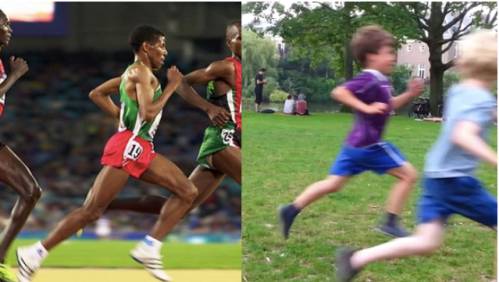Running injuries
 These two pictures put side by side show how from childhood we have good hip extension. The knee of the back leg is almost a straight line with hips and abdomen and chest. Haile Gebrselassie hasn’t lost that full hip extension either!
These two pictures put side by side show how from childhood we have good hip extension. The knee of the back leg is almost a straight line with hips and abdomen and chest. Haile Gebrselassie hasn’t lost that full hip extension either!
However for most of us that have desk based jobs our hip flexors – the ones that help us bend at the waist- become tighter and can keep us in a slightly flexed position. In turn this means that when we run we do not get full extension at the hip.
Why does this matter?
1) Increased risk of running injuries
If our hips remain slightly flexed through the gait cycle then the femur (thigh bone) is always slightly rotated inwards. This in turn can put extra strain on the IT band, the knee and the hip bursa which can leading to strain injuries in these areas.
We can also try to over compensate with a short back swing and with a longer stride. This takes up more energy too and can lead to greater strain on the knee and foot leading to Achilles tendonitis and patella femoral pain syndrome (pain behind the knee cap)
Alternatively, runners gain extra hip ‘extension’ by arching their lumbar spines and this in turn can lead to lumber spine pain.
2) Reduced running efficiency
It also does not allow for most efficient running. When your hip reaches full extension you have stored maximum potential energy in the hip flexor muscles (psoas, iliacus and rectus femoris) which turns into Kinetic energy on the swing phase of the run as you bring your leg forward for the next step.
And so we can expend more energy in running with less hip extension.
What can you do ?
Running injuries tend to be multi-factoral but a lack of Hip flexion is often involved.
To help increase hip extension you need to work on lengthening your hip flexors (psoas, iliopsoas and Rectus Femoris) as well as activating and strengthening your Gluteal muscles.
And then consider how to incorporate this into your running posture. Look up as you run and run with a more upright stance. This will help with a greater degree of extension at the hip.
Here are two key exercises designed to help you do just that
Do them daily am and pm 10-15x each and work them into your warm ups and warm downs
Hip flexor stretch- a guaranteed antidote to sitting at your desk and shortened hip flexors
Hip extensor activation- Gluteal (buttock) strengthening

Hugo Firth BOst, BSc, MA
Osteopath and
Sports Rehab Specialist
Member of the Institute of Osteopaths



